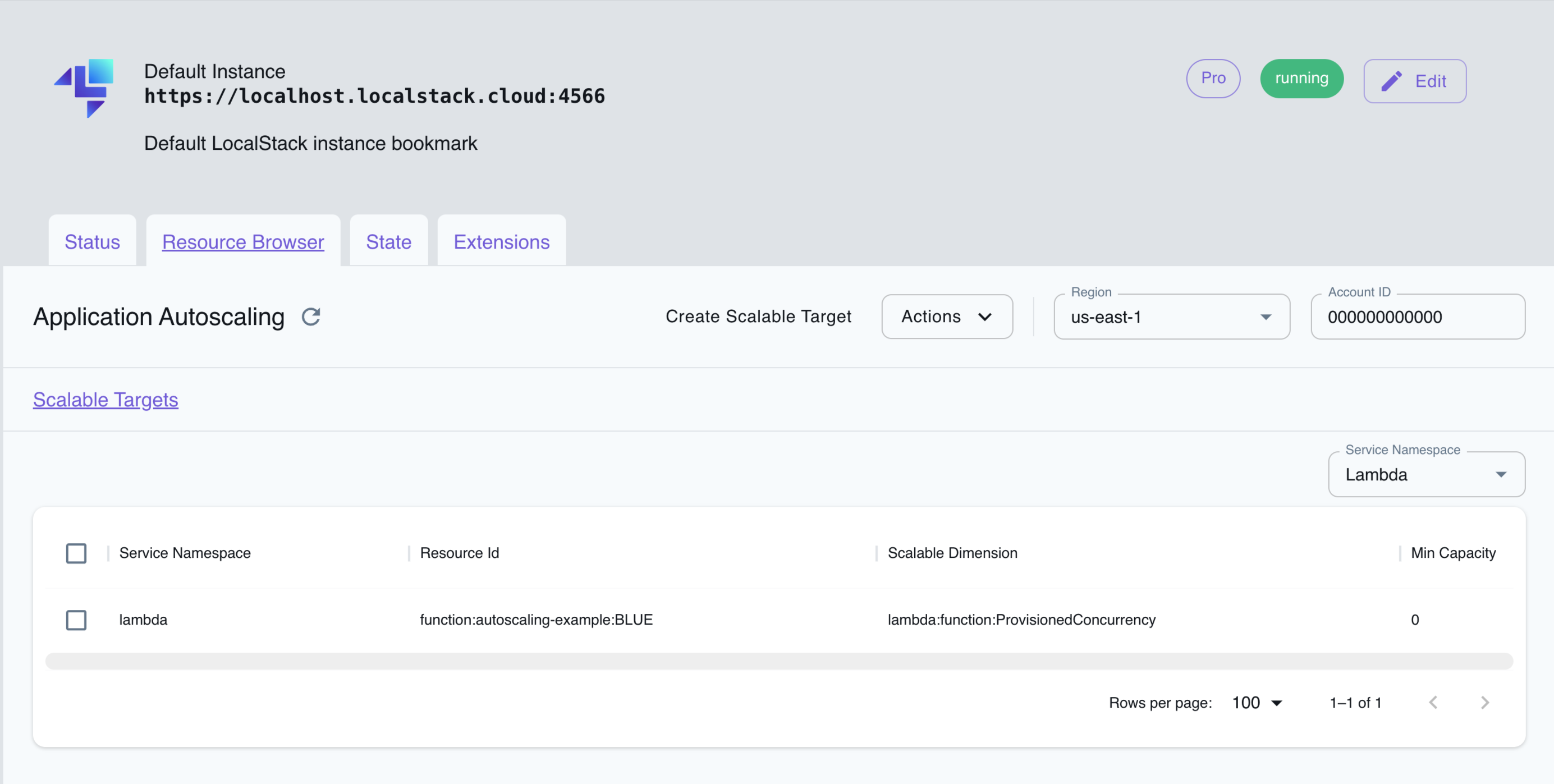Application Auto Scaling
Introduction
Section titled “Introduction”Application Auto Scaling is a centralized solution for managing automatic scaling by defining scaling policies based on specific metrics. Based on CPU utilization or request rates, it automatically adjusts capacity in response to changes in workload. With Application Auto Scaling, you can configure automatic scaling for services such as DynamoDB, ECS, Lambda, ElastiCache, and more. Auto scaling uses CloudWatch under the hood to configure scalable targets which a service namespace, resource ID, and scalable dimension can uniquely identify.
LocalStack allows you to use the Application Auto Scaling APIs in your local environment to scale different resources based on scaling policies and scheduled scaling. The supported APIs are available on our API Coverage section, which provides information on the extent of Application Auto Scaling’s integration with LocalStack.
Getting Started
Section titled “Getting Started”This guide is designed for users new to Application Auto Scaling and assumes basic knowledge of the AWS CLI and our awslocal wrapper script.
Start your LocalStack container using your preferred method. We will demonstrate how you can configure auto scaling to handle a heavy workload for your Lambda function.
Create a Lambda Function
Section titled “Create a Lambda Function”To create a new Lambda function, create a new file called index.js with the following code:
exports.handler = async (event, context) => { console.log('Hello from Lambda!'); return { statusCode: 200, body: 'Hello, World!' };};Run the following command to create a new Lambda function using the CreateFunction API:
zip function.zip index.jsawslocal lambda create-function \ --function-name autoscaling-example \ --runtime nodejs18.x \ --zip-file fileb://function.zip \ --handler index.handler \ --role arn:aws:iam::000000000000:role/cool-stacklifterCreate a version and alias for your Lambda function
Section titled “Create a version and alias for your Lambda function”Next, you can create a version for your Lambda function and publish an alias.
We will use the PublishVersion and CreateAlias APIs for this.
Run the following commands:
awslocal lambda publish-version --function-name autoscaling-exampleawslocal lambda create-alias \ --function-name autoscaling-example \ --description "alias for blue version of function" \ --function-version 1 \ --name BLUERegister the Lambda function as a scalable target
Section titled “Register the Lambda function as a scalable target”To register the Lambda function as a scalable target, you can use the RegisterScalableTarget API.
We will specify the --service-namespace as lambda, --scalable-dimension as lambda:function:ProvisionedConcurrency, and --resource-id as function:autoscaling-example:BLUE.
Run the following command to register the scalable target:
awslocal application-autoscaling register-scalable-target \ --service-namespace lambda \ --scalable-dimension lambda:function:ProvisionedConcurrency \ --resource-id function:autoscaling-example:BLUE \ --min-capacity 0 --max-capacity 0Setting up a scheduled action
Section titled “Setting up a scheduled action”You can create a scheduled action that scales out by specifying the --schedule parameter with a recurring schedule specified as a cron job.
Run the following command to create a scheduled action using the PutScheduledAction API:
awslocal application-autoscaling put-scheduled-action \ --service-namespace lambda \ --scalable-dimension lambda:function:ProvisionedConcurrency \ --resource-id function:autoscaling-example:BLUE \ --scheduled-action-name lambda-action \ --schedule "cron(*/2* ** *)" \ --scalable-target-action MinCapacity=1,MaxCapacity=5You can confirm if the scheduled action exists using DescribeScheduledActions API:
awslocal application-autoscaling describe-scheduled-actions \ --service-namespace lambdaSetting up a target tracking scaling policy
Section titled “Setting up a target tracking scaling policy”You can now set up a target tracking scaling policy to scale based on current resource utilization.
You can use the PutScalingPolicy API to create a target tracking scaling policy after ensuring that your predefined metric expects the target value.
When metrics lack data due to minimal application load, Application Auto Scaling does not adjust capacity.
Run the following command to create a target-tracking scaling policy:
awslocal application-autoscaling put-scaling-policy \ --service-namespace lambda \ --scalable-dimension lambda:function:ProvisionedConcurrency \ --resource-id function:events-example:BLUE \ --policy-name scaling-policy --policy-type TargetTrackingScaling \ --target-tracking-scaling-policy-configuration '{ "TargetValue": 50.0, "PredefinedMetricSpecification": { "PredefinedMetricType": "predefinedmetric" }}'Resource Browser
Section titled “Resource Browser”The LocalStack Web Application provides a Resource Browser for managing AppConfig applications. You can access the Resource Browser by opening the LocalStack Web Application in your browser, navigating to the Resource Browser section, and then clicking on Application Auto Scaling under the App Integration section.

The Resource Browser allows you to perform the following actions:
- Create scalable target: Create a new scalable target by clicking Create Scalable Target and providing the required details.
- Filter services: Filter services by service namespace to view only the services you are interested in, by choosing from the dropdown list.
- Delete: Delete a scalable target by selecting the target, followed by clicking Actions and then Remove Selected.
The following service namespaces are currently supported:
- Elastic Container Service (ECS)
- Elastic MapReduce (EMR)
- Elastic Compute Cloud (EC2)
- AppStream
- Lambda
- DynamoDB
- RDS
- Sagemaker
- Kafka
- Cassandra
- Comprenhend
- Custom Resource
API Coverage
Section titled “API Coverage”| Operation ▲ | Implemented | Image |
|---|